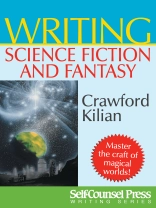Whether you are new to the genre or looking for inspiration, this book provides the tools you need to succeed. Develop believable fantasy worlds
Challenge your readers’ imaginations
Practical techniques you can apply today
Written by a successful author of SF and fantasy novels
Master the craft of magical worlds
Are you struggling to get started on your science fiction or fantasy novel? Stuck at chapter two or need a fresh approach? Find new direction and inspiration with this unique guide to creating original and convincing stories. Written by a successful author of more than ten science fiction and fantasy novels, Writing Science and Fantasy takes an in-depth look at these two best-selling genres. Kilian delves into the origins and conventions of science fiction and fantasy and goes over the many subgenres, including nanotechnology, space opera, and sword and sorcery. He forces you to ask yourself crucial questions about your own novel, and also offers practical advice on how to prepare and market your manuscript to publishers, editors, and agents. With this book as a guide, both novice and experienced writers can learn how to make their work both a literary and financial success. Learn about:
Constructing a scene
Showing versus telling
Avoiding clichés
Developing good writing and research habits
Creating plausible fantasy worlds
Using symbolism and imagery effectively
İçerik tablosu
PREFACE vii
INTRODUCTION ix
The Challenge of Writing Science Fiction and Fantasy ix
The Evolution of Myths into Stories xii
The Basic Theme of SF and Fantasy: Power xiv
PART 1: Knowing Your Genre 1
1 HARD FACTS FOR FIRST-TIME NOVELISTS 3
2 THE PAST, PRESENT, AND FUTURE OF
SCIENCE FICTION AND FANTASY 10
Conventions in Science Fiction and Fantasy 11
Where Do We Go from Here? 17
3 UNDERSTANDING GENRE 20
Defining Our Terms 21
Understanding the Conventions of Your Genre 22
iii
Contents
The Subgenres of Science Fiction 25
The Subgenres of Fantasy 41
Writing for Young Adults and Children 47
4 CREATING YOUR FICTIONAL WORLD 50
Demonic Worlds and Paradise Worlds 52
A Sense of What Is Natural 53
Parallel Worlds 55
Fantasy Worlds 56
PART 2: The Craft of Writing Science Fiction and Fantasy 59
5 DEVELOPING EFFICIENT WORK HABITS 61
Routine 61
Using Dead Time Constructively 64
How Do You Get Ideas? 65
6 RESEARCH AND SOUL SEARCH 67
Library Research 69
Research on the Internet 71
From Research to Soul Search 75
Getting the Science and Magic Right 77
Setting the Limits of Magic 83
7 ELEMENTS OF A SUCCESSFUL STORY 84
Tough Questions to Ask Yourself 85
The Opening 85
The Body of the Story 89
The Conclusion 92
Throughout the Story 92
8 DEVELOPING CHARACTERS 95
What Makes a Believable Character? 95
The Character Résumé 97
9 PLOTTING 101
Basic Principles of Plotting 102
What to Do with Your Plot Elements 107
10 CONSTRUCTING A SCENE 112
iv Writing science fiction and fantasy
11 NARRATIVE VOICE 116
First Person Point of View 117
Second Person Point of View 119
Third Person Point of View 119
Hazards of Using Persona 122
Verb Tense 123
12 EXPOSITION AND DIALOGUE 124
Show or Tell: Which Is Better? 124
“Let’s Talk about Dialogue, ” He Pontificated 129
13 SYMBOLISM AND ALL THAT 134
The Natural Cycle 136
The Natural Versus the Human World 137
The Hero’s Quest 138
Symbolic Images 140
Symbolic Characters 141
Developing Your Own Symbols 142
PART 3: Getting Published 145
14 THE MECHANICS OF
MANUSCRIPT PRODUCTION 147
Exploiting Your Word Processor 147
Basic Manuscript Copyediting Principles 153
Manuscript Format 163
15 SELLING YOUR STORY 167
The Query Letter 167
Will They Steal Your Idea? 171
The Story Synopsis 171
16 RESEARCHING PUBLISHERS AND AGENTS 178
Finding the Right Publisher 179
Finding an Agent 180
17 THE PUBLISHING CONTRACT 183
Delivery of Satisfactory Copy 184
Permission for Use of Copyrighted Material 184
Grant of Rights 185
Proofreading and Author’s Corrections 186
Contents v
Advances and Royalties 186
Author’s Warranties and Indemnities 188
Author’s Copies 188
Option Clause 189
Going Out of Print 189
A Word of Advice 190
CONCLUSION 191
Is It Worth Doing at All? 191
APPENDIX 195
An Annotated Work in Progress 195
SAMPLES
1 Manuscript page 166
2 Query letter with plot summary 173
3 Features of a story synopsis 176
CHECKLISTS
1 Style for fiction writers 143
2 Copyediting 161
WORKSHEETS
1 Character Résumé 98
vi Writing science fiction and fantasy
Yazar hakkında
Crawford Kilian has been teaching and writing online since the 1980s. He developed Capilano University’s first online writing course, as well as teaching how to write for multimedia and the web. Kilian has published over 20 books as well as hundreds of articles both in print and online. He is a contributing editor of The Tyee.ca, and runs numerous blogs. His Self-Counsel books include Writing for the Web, Writing Science Fiction & Fantasy, and Sell Your Nonfiction Book.












